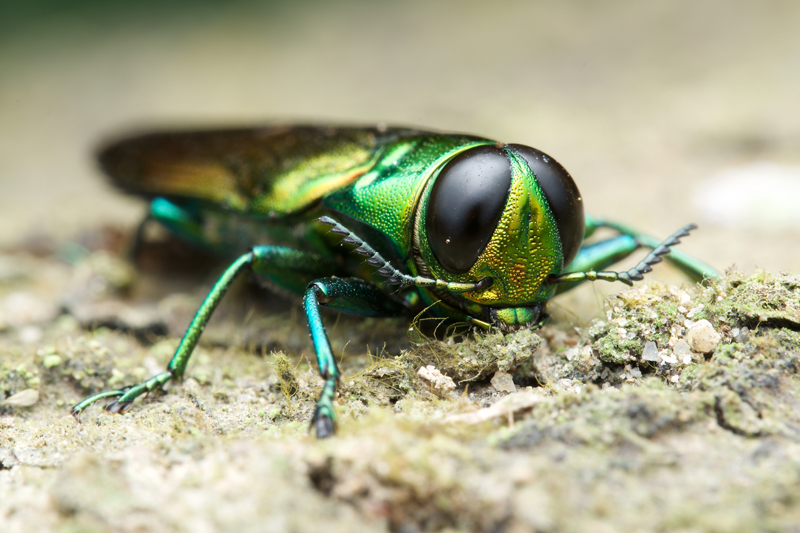For nearly two decades, we’ve seen an increase in infestations of the Emerald Ash Borer (EAB). This insect attacks and destroys one of the most prevalent tree species used in urban and suburban settings, the ash tree. Known as a favorite for its colorful fall foliage and consistent canopies, the ash tree is popular among home owners.
How deadly can the EAB be?
There are up to 25 different species of ash in North America, with that in mind, the non-native EAB threatens more than 7.5 billion ash trees in the U.S. alone—it is nearly 40 times more harmful than the Dutch Elm Disease of the 20th century.
When EAB populations are high, small trees may die within 1-2 years of becoming infested and large trees can be killed in as little as 3-4 years. It can be absolutely devastating to an ash population with nearly a 100% kill rate if control options are not used.
That’s why we’ve connected with Jeffrey Thrasher, Central’s Liquid Chemicals and Fertilizer Products Manager, who specializes in tree and ornamental solutions to learn more about reducing the impact of the Emerald Ash Borer. He provided insight on what effective control solutions are available to help your customers protect their valuable ash trees.
From Jeffrey:
The Emerald Ash Borer is the most destructive insect to ever invade the U.S. Imported from Asia, the pest first appeared in Michigan in 2002 and has killed 60 million Ash trees in that state alone. It has now spread across more than 35 states and five provinces in Canada. However, all hope is not lost.
Native species of woodpeckers and wasps are helping to control populations, while the USDA has released imported predatory wasps in 25 states that attack and kill the Emerald Ash Borer (EAB). For homeowners seeking to protect valued ash trees, there are also have a number of control options available.
Control Solutions to Combat the Emerald Ash Borer
The first step is to commit to protecting a valued tree. Beyond aesthetic considerations the cost of protecting the tree can often be less than that of removal. Any ash tree within a thirty-mile radius of visible infestation is at risk.
Evidence of the pest includes canopy dieback, woodpecker damage, D-shaped exit holes in the bark, and water sprouts growing out of the main stem. A valued tree must be protected for at least a 5-6 year period during peak insect infestation. During this period of time, a majority of ash trees in the area will be killed the EAB populations. Once a majority of the ash trees have died, the populations of EAB will dramatically decline and the greatest hazards to the local ash trees will subside.
Fall Control for Next Season
In the fall, soil injection or drench with Imidacloprid will control next year’s infestation. For trees over 20” in diameter spring trunk injection methods provide greater control. And for trees under 20”, they can be treated in the spring with a trunk spray of Dinotefuran or soil injection of Imidacloprid. When treating with a trunk spray of Dinotefuran make sure to thoroughly soak the bark around the entire tree. Surfactants can enhance the efficacy of trunk sprays. For this treatment to be effective, make sure to apply during dry weather and allow for the chemicals to thoroughly dry. Each of these control options will protect the tree for one season.
All-natural or environmentally friendly products are in high demand from consumers, especially now that more people are working from home and spending time in their outdoor spaces. For customers looking for an environmentally friendly method of EAB control, you can use Azadirachtin. This material is made from neem seeds, which are not harmful to birds or bees. Azadirachtin must be injected into the main stem in the spring after leaf expansion. Each tree should be measured for the appropriate dosage and follow manufacturer’s instructions for dosage quantities when treating the tree.
Spring Control for the Future Seasons
Many parts of the New England and Mid-Atlantic states continue to be at peak levels of infestation. In these states, adult EAB beetles will lay their eggs in late June and July. The larvae will emerge in approximately three weeks after the EAB lay their eggs.
This means, it’s critical for you to apply control measures early in the season. The best time to apply soil drench, soil injection, or trunk drench is early spring. For main stem injections and main trunk injections the best time is right after leaf expansion. Due to the time needed for the tree to translocate an insecticide, the window for controlling larvae is short and must be done early to be effective.
Central is here to help. If you have questions or need other recommendations, contact your local Central rep. We’re always adding new and innovate products to our warehouses to make sure we’re meeting [and exceeding] your needs. If you are interested in how you can add tree & ornamental control to your service offerings, let us know. We stay at the leading edge of the industry and we’re ready to help you grow!
About Jeffrey Thrasher
Jeffrey Thrasher is a licensed Arborist with more than three decades of experience in the Green Industry. Jeffrey built a successful tree, lawn and landscape company in Westchester County, NY and Fairfield County, CT. After selling his business, he began work with fertilizer manufacturers to establish distribution nationally. This extensive hands-on knowledge and background has given Jeffrey the necessary tools and background to troubleshoot and solve the most difficult tree and ornamental issues. Jeffrey is an excellent resource to help you finding the right product and solution for your customers.

